Add product recommendations
Add product recommendations
Step 1: Choose where to apply product recommendations
Before you continue, you’ll need to familiarize yourself with what a Placement is.
|
|
Leading-practice
Each of your campaigns must be added to one of the Placements available to you. You can only have one active campaign in a Placement at any one time. |
Create a new campaign
On the home page, create a new Product recommendations campaign.
-
Click Home from the sidebar.
-
On the Product recommendations card, click Create now.
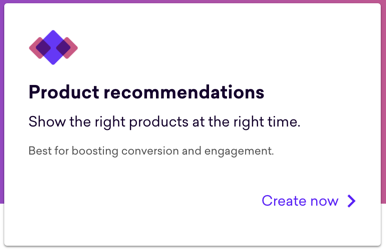
Choose a Placement
Select a Placement you’re interested in using.
By hovering over a Placement, you’ll see a preview of what it will look like on your site in order to visualize which part of the page you’re personalizing. In addition, the preview indicates what content you may need to add.
This "Homepage merchandising slot" Placement requires an audience, message, a link, and an image:
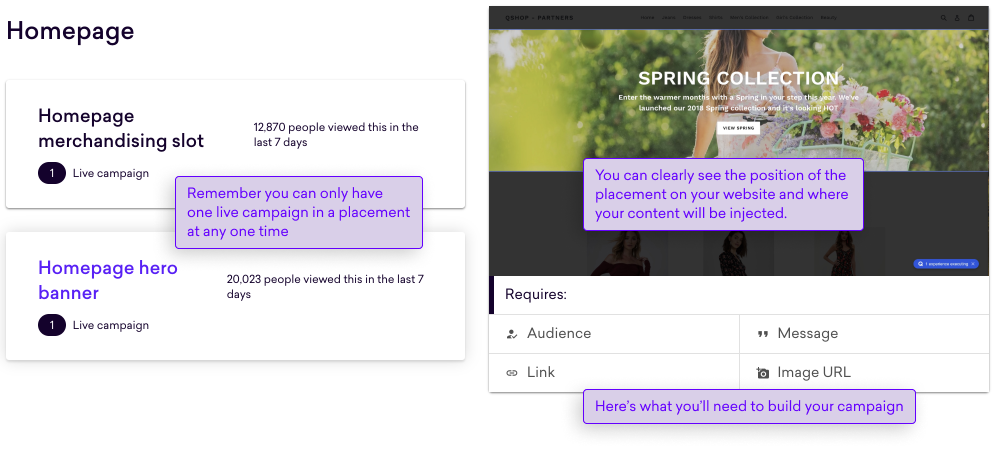
|
|
Note
If the preview isn’t working, it’s possible that your dev team didn’t upload images of your site during the onboarding process, so it’s worth checking in with them. If everything checks out on your side, reach out to your CSM at Coveo. |
Step 2: What products to recommend and to whom
In this step, you’ll learn about the different recommendations strategies you can choose from, how to create rules to customize the products in your carousel, how to draw visitor attention to your recommendations carousel, and how to create an audience to define who will see it.
Adding the recommendation
Before configuring a recommendation, you need to add it. Go ahead and click Add recommendations
Adding a catalog
This step lets you define the set of products that are eligible for a visitor, using their specific language and currency. You can assign one or more catalogs to a recommendation.
|
|
Note
Recommendations are only shown to users whose language and currency match the catalogs you’ve selected. Select multiple catalogs with the same language to reuse text such as the recommendation heading. |
To review the catalogs set up for your property, refer to the product catalog viewer.
If your property only has one catalog, you can skip this step.
Adding an audience
An audience is the group of customers that you’re looking to target with your experience. If you want to display your experience to every visitor, choose All visitors.
If an audience was already created for another campaign types, you could re-use them, or create a new one.
To use an existing audience, select it from All audiences or search for it.
To create a new audience
-
Click Create audience and give it a name.
Leading-practiceTo help others in your team find audiences, it’s recommended that you use a name that describes what sort of people you want to target. For example, "People that have fewer than five conversions that are viewing jackets and are in London."
-
Select the attributes you want to use and enter any details required by the attribute like
is less thanand a value to go with it, like 5.Here’s an example for the first part of our audience:

-
Audience attributes form a combined
ANDcondition.
For example, only people with less than five conversions
ANDwho has less then five sessions will see the experience. -
If an attribute has multiple conditions, they form an
ORcondition within that attribute.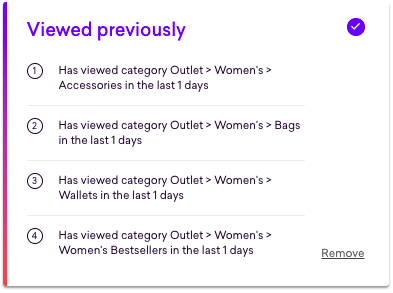
For example, visitors who have viewed the first category OR the second category OR etc., will see the experience.
In addition to using predefined attributes to target audiences in general, you can also target specific users directly by uploading a CSV file that contains the targeted users emails, user IDs or visitor IDs. All of this is done in the section displayed below:
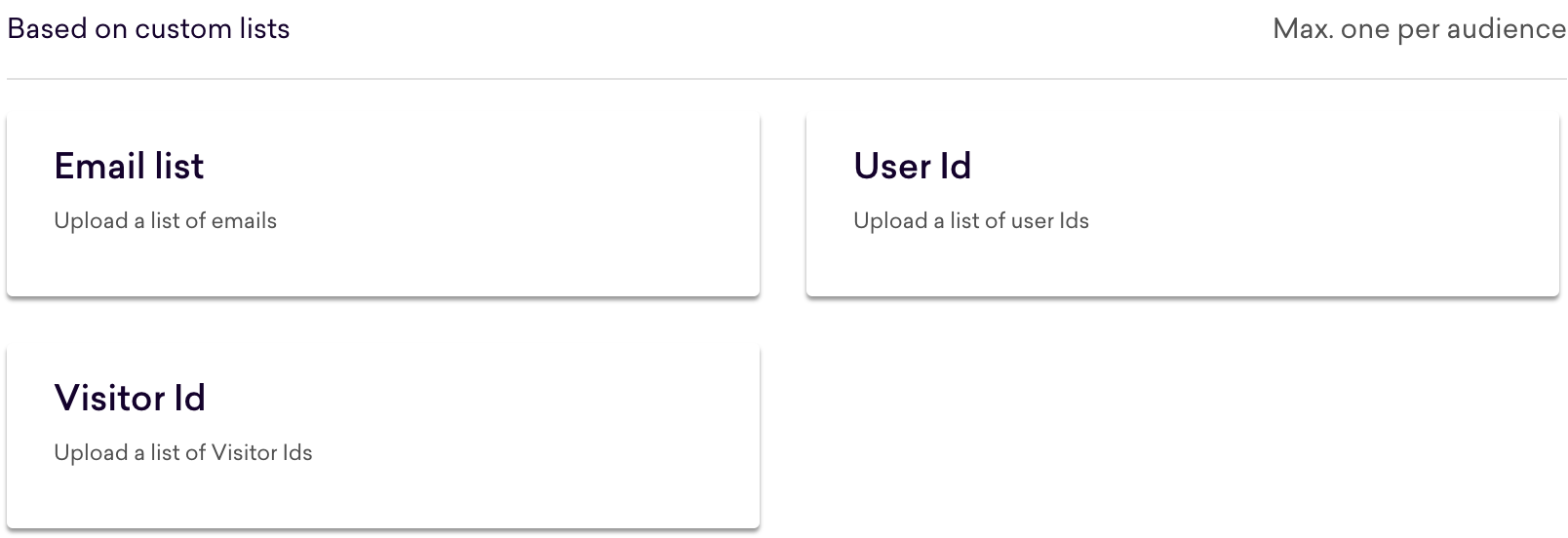
The format of the CSV file containing the user information should be:
<header> value1 value2 value3An example of what a CSV file will look like for an email list is:
user_email abc@def.com ghi@jkl.com -
-
Click Save when done. You can always edit or remove the attribute later.
-
To finish creating the audience, click Next.
Choosing a strategy
Deciding which products to show starts by choosing a strategy. This choice depends on your business goals. For example, you might be looking to increase conversions, build engagement through exposing more of your product catalog, or highlight trending products to inspire your customers.
In Coveo Experience Hub, you can choose from one of Google’s recommendations strategies or one of Qubit’s. For each strategy, the Coveo Experience Hub provides details about where it’s best used and the business goal. You can find a bit of extra information about each one in Recommendations strategies available in Experience Hub.
Click either Google Cloud or Qubit and then the card for the strategy you want to use.
Customization
Specify a heading
By default, your carousel is introduced with a default heading based on the strategy you selected. You can change this by altering the recommendation’s heading.
It’s suggested that you tailor the message to the strategy you’ve chosen for your campaign. Here are a few examples:
-
Looking for recommendations?
-
Recommended for you
-
Top picks
-
Trending right now
-
Just for you
|
|
Leading-practice
If you’re creating recommendations for multiple catalogs that have different languages, remember to translate the heading in each recommendation to match the catalog’s language. |
Adding more content
If your placement has custom fields added to it, you’ll be able to populate them at this stage.
Choose what "popular" means
|
|
Note
This option is available only for the "Popular products" strategy. |
You need to choose how your campaign would define what products are popular.
-
Views (Default)—show most viewed products.NoteThis option locks the Timeframe option at
Last 30 days. -
Revenue—show products that generated most revenue. -
Conversions—show products that sold most SKUs. -
Blended—show products based on the combination ofRevenueandConversionscores.
Specify timeframe for "Popular products"
If you’re setting up a "Popular products" strategy, you need to specify the timeframe when popular products were shown.
The strategy will recommend the products with the highest value of Revenue/Conversion/Blended from the previous N days.
-
Last 7 days: Shows popular products in the last 7 days, compared to the previous 8 to 100 days. -
Last 28 days: Shows popular products in the last 28 days, compared to the previous 29 to 100 days. -
Last 90 days: Shows popular products from the last 90 days, compared to the previous 91 to 200 days.
Specify timeframe for "Promote new products"
If you’re setting up a "Promote new products" strategy, you need to specify the timeframe when products were shown for the first time, that is, new products.
The strategy will prioritize recommending new products over those first displayed during the previous N days.
-
Last 7 days: Displays products that were first viewed in the last 7 days, compared to the previous 8 to 100 days. -
Last 28 days: Shows products that had the first view in the last 28 days, compared to the previous 29 to 100 days. -
Last 90 days: Shows products that had their first view in the last 90 days, compared to the previous 91 to 200 days.
Adding rules
Rules allow you to customize your chosen strategy and fine-tune the products shown in the carousel. Rules will help you to:
-
Align your product recommendations with other campaigns and promotions you might be running
-
Take action on the outcome of your trading meetings, perhaps by promoting a particular product line
-
Exclude products that are out of stock
The anatomy of a rule
Each rule consists of a simple condition:
"if people in the audience are viewing"
To this, you add an attribute, for example, "product name," "product category," or "price":
"if people in the audience are viewing products in the dresses *category*"
Then an action, for example, "exclude" or "promote":
"if people in the audience are viewing products in the dresses category then *promote*"
And finally, the products you want to action, in this case, promote, again based on product attributes:
"if people in the audience are viewing products in the dresses category then promote products in the category shirts"
Rule attributes mapping
There are two types of catalogs that you can use:
Some rule attributes are mapped differently, depending on what type of catalog you’re using.
|
|
The use of the Products+variants catalog in the Experience Hub is in early development. To be able to use that catalog in you account, contact your CSM (Customer Success Manager) or Coveo Support. |
The Products+variants catalog comprises a nested structure of fields with group IDs (ec_item_group_id) as the top-level containers for products.
If at least one product within the group matches the rule condition, the rule will be applied.
In case of a Products+variants catalog, you can only create rules for the product fields, but not for the variant fields.
| UI name | Products catalog field | Products+variants catalog field | Notes |
|---|---|---|---|
Gender |
|
|
This isn’t a standard field in a Products+variants catalog, so it’s not available as a rule attribute if a Products+variants catalog doesn’t have it. |
Brand |
|
|
|
Stock |
|
Not available. |
An integer number of units in stock.
By default, the Recs API removes products that are out of stock (
|
Product name |
|
|
|
Product Id |
|
Not available. |
When a Products+variants catalog is imported into the Experience Hub, you would see the Group ID attribute in the rules builder instead of Product Id. |
Group Id |
Not available. |
|
|
Price |
|
Not available. |
When a Products+variants catalog is imported into the Experience Hub, you would see Min Price and Min Promo Price attributes in the rules builder instead of Price. |
Min Price |
Not available |
|
|
Min Promo Price |
Not available |
|
|
Category |
|
|
Mapped from the In a Products catalog imported from CEH, multiple categories:
In a Products+variants catalog, multiple categories:
Example
|
Adding a rule
|
|
Global rules created in Coveo Experimentation Hub won’t be applied to Experience Hub campaigns using a Products+variants catalog. |
Let’s have a go at creating that rule.
|
|
Leading-practice
To get a heads-up on the potential impact of your rules before going live with your campaign, you’ll have to update the carousel preview as you add rules. |
Look what happens to your carousel when you exclude products below £20:

Step 1
Click Edit rules and then Create new rule
Give your rule a name.
You can use Promote shirts with dresses
Step 2
By default, the rule condition will be people in the audience viewing any product.
We’ll need to change that, so click any product
Now click Category, is, and enter Dresses in the field provided:
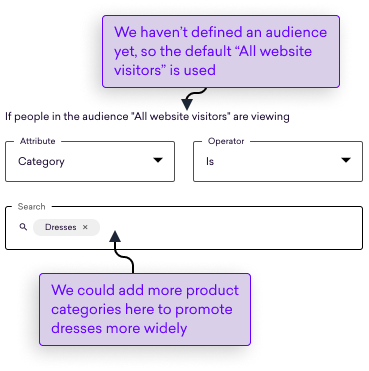
Click Save
Step 3
Click Promote to increase the likelihood that shirts will appear in the carousel
Step 4
Now, in Products, click the Category attribute, the operator is, and enter shirts in the field provided
That’s it! Click Save and continue to finish up
|
|
Note
Of course, you can create far more complex rules than the one you just added, but we recommend that you start with some simple rules and observing the results on the carousel before adding others. Don’t forget to check out the FAQ at the end of this article to find out more about this. |
So, now you’ve chosen a strategy and added some rules to customize your carousel:

Adding more recommendations
As mentioned before, a campaign can have more than one recommendation. This is a great way to differentiate your carousel’s behavior based on a visitor's audience or to manage multiple catalogs. To do this, simply click Add recommendations and repeat the steps above for your next set of visitors.
Ordering recommendations
|
|
Note
Remember that only customers that are members of an audience and that match the selected catalog(s) can see the recommendations. |
When you have a campaign with more than one recommendation, it’s possible that a person could be a member of more than one audience in the campaign and potentially see both recommendations. Why?
To get around this potential conflict, you can order your recommendations by dragging them. Customers that fall into more than one audience will be shown the recommendation at the top of the list.
Here you can see a drag in progress:
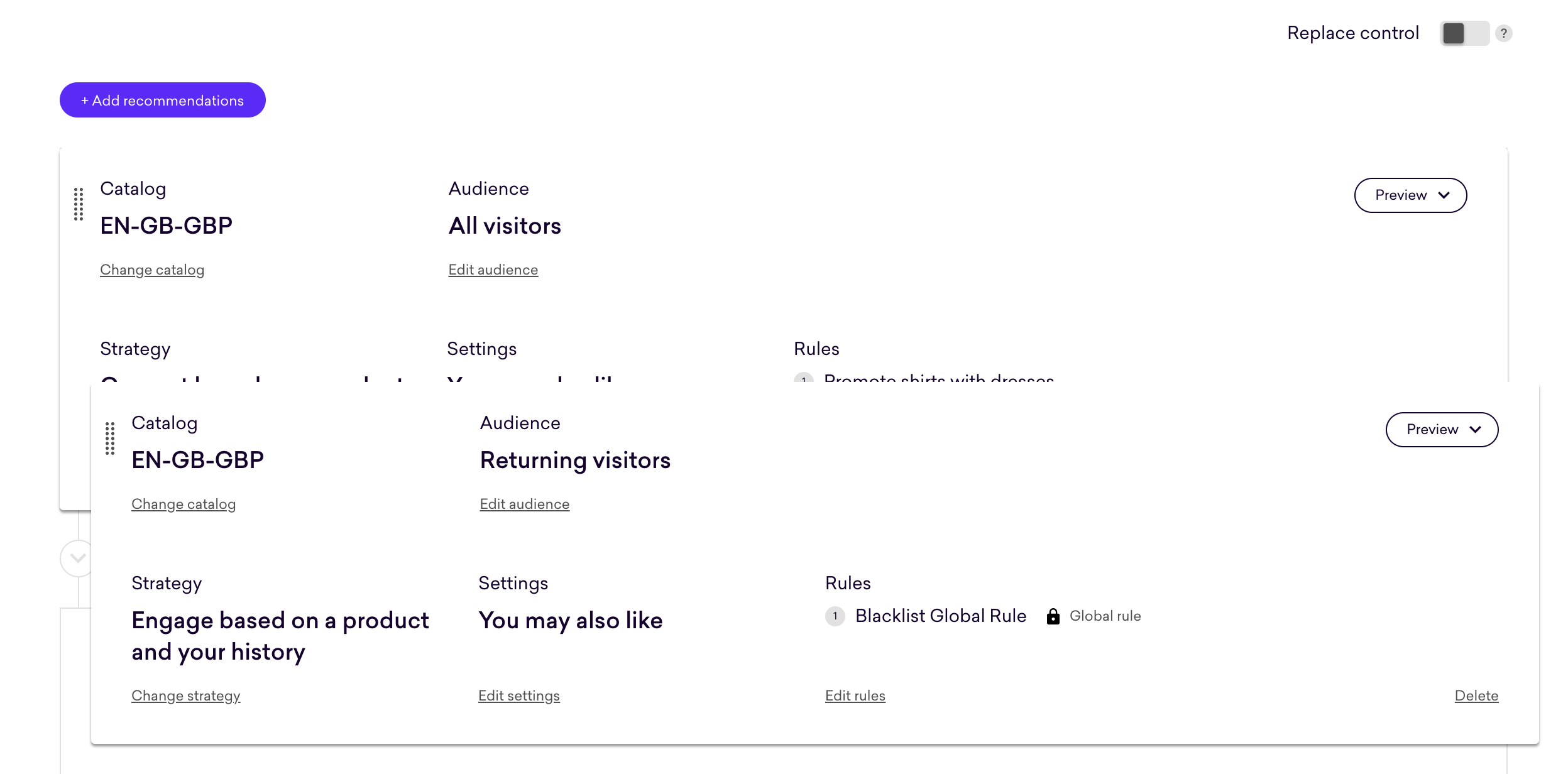
Previewing your recommendations in the app
Once you’ve set up your recommendations campaign, you’ll want to ensure it behaves as you would expect it to. You can use the in-app preview to test behavior for different audiences, catalogs, and seed products, for seeded placements.
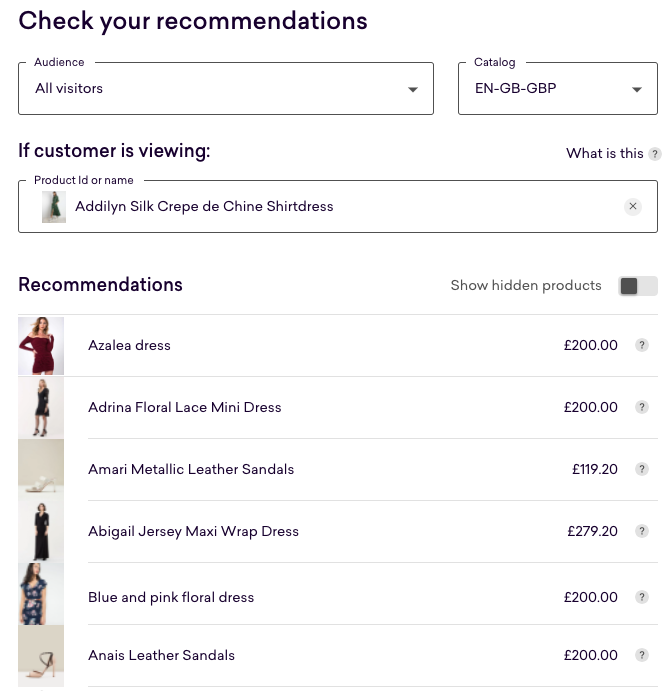
|
|
Note
Personalized strategies, like the Google strategies that account for a visitor's history, can still be previewed in the app. The preview won’t be personalized, however, and will reflect the experience of a brand new user. Preview the strategies on your site to get a feel for how the personalization behaves |
Previewing your recommendations on your site
Previewing is a great way to test your campaign by replicating the customer journey. When you preview, you can see the campaign as one of your customers would see it.
Coveo Experience Hub offers two ways to preview:
-
Preview an experience. This bypasses any audience conditions and rules and shows you how the experience will look to a visitor in the experience. This is a great way to validate the look and feel of your experience.
Click Preview on an experience card to preview the experience.
For mobile, click …on mobile and scan the QR code with the mobile device you want to preview on.
NoteIt can be confusing to preview your experiences when your audience condition targets URLs. This is because you use the Placement’s default preview URL, which may not match your audience conditions. The "Preview campaign" button is a great way to validate that URL matching conditions are working as expected.
-
Preview the entire campaign. This is a great way to validate the live user journey and is fully representative of the final user experience. You will only see content if you match the configured audience conditions and rules
Click Preview campaign to preview your campaign.

Here’s an example of our carousel on web:
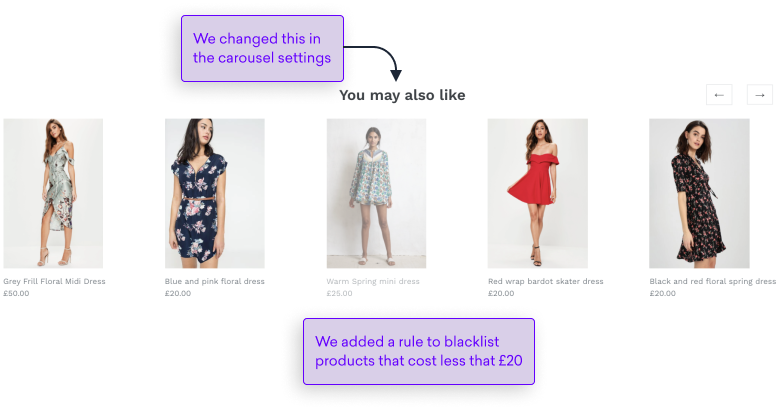
FAQ
What’s a global rule?
Global rules are rules added by your Qubit team when your specific use case isn’t covered by the rules available in the Experience Hub. Please reach out to your CSM at Qubit to discuss global rules.
How do global rules interact with my campaign rules?
It’s important to understand that rules created for specific campaigns will interact with global rules and any custom rules added by the Experience Hub for your property. What does this mean?
Well, for example, suppose you have a global rule to promote products in the category Bed Sheets - Valences and a second rule for a campaign that also promoted a smaller set of products, perhaps by product attribute, in the same category. In this instance, you would promote all products in the category and promote even further that smaller set of products targeted by the campaign-level rule.
|
|
Leading-practice
A good rule of thumb is the more a product is promoted, the more likely it’s to be recommended. |
It’s also possible that a rule for a specific campaign could exclude a product promoted in a globally-applied rule. In this instance, the exclusion rule would supersede the promotion rule.
Step 3: Set visibility for your product recommendations
In this step, you’ll learn how to choose how to decide what percentage of an audience sees your campaign. The Coveo Experience Hub will provide useful information about each option to help you select the most appropriate option.
Controlling visibility
You might not always want all of the people in your audiences seeing the campaign you’ve built. This might be because you are not confident in the result, and you need to manage that risk, or because you are looking to A/B test a campaign. So in this step, you’ll learn how to decide what percentage of an audience sees the campaign.
|
|
Note
The people that don’t see the campaign will see your default website content, often referred to as the control. FYI, if you’re going to use the correct term, the campaign would be the variation. |
Let’s look at the choices.
-
50% - this is a good choice for campaigns when you are trying out something completely new for your website. This might be a new style of messaging, new promotions that you’ve never run before, etc. 50% of the people in the audience will see the campaign, and 50% the control
-
95% - this is a good choice for campaigns when you need to reach out to as many people as possible, especially when you are trying to deliver on actions that came out of your weekly trade meeting, but still need to monitor your campaign’s performance against goals. 95% of the people will see the campaign and 5% the control
-
100% - this is a good choice for campaigns when you want to reach out to all of the people in an audience and are confident that your campaign will have a positive impact on goals. With this option, there’s no A/B testing and therefore no performance comparisons
|
|
Note
You cannot select 100% when you have chosen to replace your control because it would mean none of your visitors would see your baseline variant. |
Go ahead and select one of the available audience splits. Click Save and continue to move to the final step in the build flow.
Reviewing estimated campaign exposure
When you make a selection, the Experience Hub will estimate the number of people that will see the campaign each week. This estimate is based on the last seven days of data from your property and the attributes you’ve defined for your audiences. In this example, you can see that the estimation is 27,000:

|
|
Note
It’s worth considering that the narrower the focus of an audience, the lower the number of people that will see your campaign will be. You can confirm this by reviewing the estimation for each of the audience splits. |
Step 4: Decide when to make your product recommendations visible
In this step, you’ll learn how to use a schedule to start and pause a campaign automatically.
Scheduling your campaign
Scheduling is a good option if you would like to time a campaign to automatically start and end in line with weekend messages, late-night cut-offs, Black Friday messaging, or other promotions you might be running.
Before adding a schedule, it’s a good idea to review the following points:
-
The time zone used for scheduling is the time zone configured for your property. You can see this in the
Scheduling calendar. -
The start date/time is optional, but it must be in the future and before the end date if set. Without a start date/time, you’ll have to launch it manually.
-
The end date/time is optional, but it must be after the start date/time if set. Without an end date/time, your campaign will run until you pause it manually.
-
Schedules for campaigns in the same Placement can’t overlap. Of course, you’ll be notified if this happens.
-
Once live, as with all the options you’ve chosen for your campaign, you can make changes to your schedule and even end it before its scheduled end date/time.
In the following example, you can see that the user has added a second campaign, "My second campaign," with a schedule that overlaps with "My first campaign":
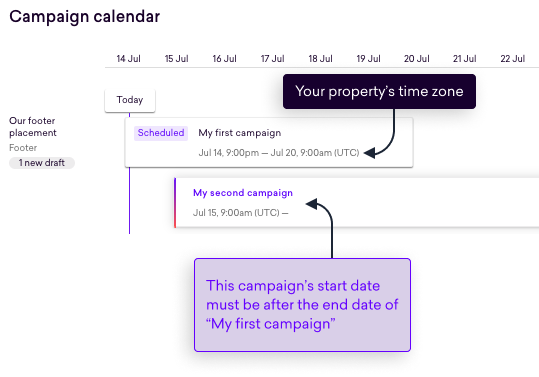
Adding a schedule
Entering a start date/time
Remember that you’ll have to start your campaign manually if you don’t enter a start date/time.
Make a selection from the date picker
Enter a start time and make sure you select either am or pm
In the example, the start date is 27 July 2020 at 9 AM:
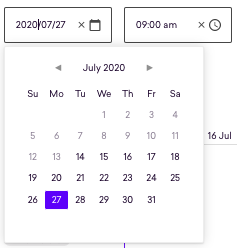
Entering an end date/time
Remember that you’ll have to pause your active campaign manually if you don’t enter an end date/time.
Follow the same steps to enter an end date/time
Editing and removing a schedule
You can review your schedule in the final build step. You can make any changes necessary by selecting Edit:

You can also edit any active campaign and make changes to the schedule, pause it manually to end it ahead of its scheduled end date or remove the end date to allow it to run continuously.
Step 5: campaign performance
In this step, you’ll learn how to name your campaign, perform a final review, and launch it on your website.
Naming the campaign
All campaigns need a name, not least because it will help you and others in your team find it in your dashboard.
Enter a name in the field provided. It’s always a good idea to stick to any conventions you work with when naming campaigns.

Reviewing the campaign
Before launching your campaign, it’s always recommended that you review it.
All the information you need to do this is shown in Campaign summary.
Coveo Experience Hub shows you the Placement you chose, the audience split, and the content in your experience. For each of these campaign elements, you can use the Edit button to make changes:
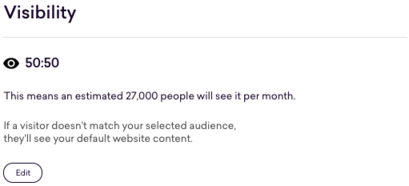
|
|
Leading practice
To include a team member in the review process, you can send them a direct link to your campaign. To do this, select Copy page link and then fire it over to them. Following the link, they’ll land right on the review step. Pretty handy, huh? |
Previewing the campaign
If you haven’t already done so, now is the final chance you’ll get to preview your campaign before launching it. You should be checking the basics:
-
Make sure the campaign displays where you intended it to
-
Review the content you added
-
Check images render correctly and any links work
-
Review your audiences
The Coveo Experience Hub offers two ways to preview:
-
Preview an experience with the "Preview" button in each experience card. This bypasses any audience conditions or rules, and shows you how the experience will look to a visitor in the experience. This is a great way to validate the look and feel of your experience
-
Preview the entire campaign with the "Preview campaign" button. This will show you the actual campaign a visitor would see. This is a great way to validate the live user journey and is fully representative of the final user experience. Content will only show if you match the configured audience conditions and rules.
Launching the campaign
When you are happy with what’s been set up in the campaign and you, and perhaps others, have reviewed it, you have the green light to launch it.
Select Launch campaign. Your campaign will be launched immediately for your customers to see.
|
|
Note
Of course, it will take some time for you to see whether the campaign is doing well or not. As a minimum, for campaigns with a 50:50 or 95:5 split, you’ll need to see 500 converters in the control and variation (your campaign) before you can start to provide feedback. |
Next steps
If this is your first campaign in the Experience Hub, congratulations. That was relatively straightforward, don’t you think?

Pretty soon, you’ll be able to see how your campaign is doing, and then, when you’re confident about the results, the Experience Hub will make a suggestion about how you can supercharge your campaign–this might be a recommendation to expose your campaign to people, for example.
While you’re waiting for the results to come in for this campaign, you can check in with your other campaigns to see how they’re performing and the wider impact your campaigns are having on your website.
Select Campaigns from the side menu to get the sitewide impact of all your campaigns
The next step is understanding the impact of your {campaign} in link:{site-baseurl}/qbb1t244/[See how your campaigns are performing].